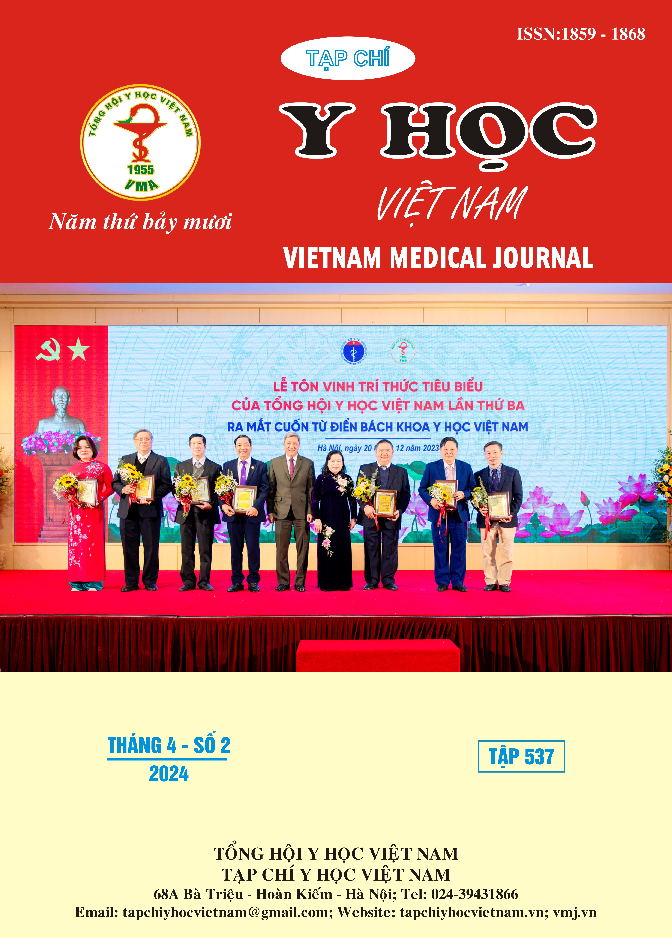A STUDY ON THE USE OF MEDICINES IN PERIOPERATIVE ON PREGNANT WOMEN WITH A HISTORY OF ALLERGIES AT PHU SAN HANOI HOSPITAL IN 2021-2022
Main Article Content
Abstract
Aims: To study on clinical characteristics and drugs use in pregnant women with a history of allergies and to evaluate the relationship between clinical characteristics and drug use initially at Phu San Hanoi Hospital in 2021-2022. Methods: Cross-sectional descriptive study conducted on 167 pregnant women with a history of allergies who were prescribed allergy testing from March 21, 2021 to December 31, 2022 and undergoing procedures and surgeries at Phu San Hanoi Hospital. Results: Among 167 pregnant women included in the study, the most comon reproductive age range were from 25 to 34 years old (68.86%), BMI was in the pre-obese range (56.3%) and ASA 2 (96.4%). The most common history of allergic agents is antibiotics and NSAIDs-paracetamol (both 25.2%). In skin test results, NMBAs and Opioids (both accounting for 58.7%) are the drug groups with the highest positive rate. 12 (7.2%) cases of pregnant women had perioperative allergies. On average, each pregnant woman uses 10 types of medicine, most pregnant women use at least 1 type of antibiotic, uterotonic, or anesthetic. In 12 cases of pregnant women having allergic reactions, the average age of this group was 29.92 ± 5.57 years; BMI is 25.56 ± 2.93. There were 10 cases (83.33%) occurring in women giving birth by cesarean section, all delivered at 39 weeks, and 1 woman had a negative skin test. 12 cases of drug reuse had positive skin test results and 4 pregnant women had allergic reactions. With uterine contraction agents, the rate is highest (41.7%). Allergic outcomes occurred more frequently in the total drug quantity, intravenous drug quantity, and postpartum groups; Statistically significant difference between allergy results and drug quantity with p<0.05. The average number of days of treatment for the group with allergic reactions was 3.92 ± 2.47 days, higher than the group without allergic reactions, which was 3.13 ± 1.45 days, with p = 0.089, with no difference. the difference is statistically significant. Conclusion: The rate of pregnant women with a history of allergies experiencing hypersensitivity reactions is much higher than the rate in the world. The specificity of skin testing needs to be further researched and allergic cases can be prevented through skin test results along with detailed allergy history before using the drug. The number of drugs used during surgery or procedures was higher in the group with allergies than in the group without.
Article Details
Keywords
Perioperative hypersensitivity, pregnant women, perioperative drug, history of allergies, skin test
References
2. McCall S, Bunch K, Brocklehurst P, et al. The incidence, characteristics, management and outcomes of anaphylaxis in pregnancy: a population-based descriptive study. BJOG Int J Obstet Gynaecol. 2018;125(8):965-971. doi: 10.1111/1471-0528.15041
3. McCall SJ, Kurinczuk JJ, Knight M. Anaphylaxis in Pregnancy in the United States: Risk Factors and Temporal Trends Using National Routinely Collected Data. J Allergy Clin Immunol Pract. 2019;7(8): 2606-2612.e3. doi: 10.1016/ j.jaip.2019.04.047
4. McCall SJ, Bonnet MP, Äyräs O, et al. Anaphylaxis in pregnancy: a population-based multinational European study. Anaesthesia. 2020;75(11):1469-1475. doi:10.1111/anae.15069
5. Gonzalez-Estrada A, Campbell RL, Carrillo-Martin I, Renew JR, Rank MA, Volcheck GW. Incidence and risk factors for near-fatal and fatal outcomes after perioperative and periprocedural anaphylaxis in the USA, 2005–2014. Br J Anaesth. 2021; 127(6): 890-896. doi: 10.1016/j.bja.2021. 06.036
6. Desravines N, Waldron J, Venkatesh KK, Kwan M, Boggess KA. Outpatient Penicillin Allergy Testing in Pregnant Women Who Report an Allergy. Obstet Gynecol. 2021;137(1):56-61. doi:10.1097/AOG.0000000000004213
7. Odor PM, Bampoe S, Moonesinghe SR, et al. General anaesthetic and airway management practice for obstetric surgery in England: a prospective, multicentre observational study*. Anaesthesia. 2021;76(4): 460-471. doi:10.1111/ anae.15250
8. Obstetric anaesthetic practice in the UK: a descriptive analysis of the National Obstetric Anaesthetic Database 2009–14 - British Journal of Anaesthesia. Accessed May 27, 2023. https://www.bjanaesthesia.org/article/S0007-0912(20)30539-0/fulltext
9. Thành TN, Lâm HT. KHẢO SÁT TEST DA TRÊN BỆNH NHÂN ĐƯỢC CHỈ ĐỊNH DÙNG THUỐC GÂY MÊ, GÂY TÊ. Tạp Chí Học Việt Nam. 2023;522(1). doi:10.51298/vmj.v522i1.4281
10. Marinho S, Kemp H, Cook TM, et al. Cross-sectional study of perioperative drug and allergen exposure in UK practice in 2016: the 6th National Audit Project (NAP6) Allergen Survey. Br J Anaesth. 2018;121(1):146-158. doi:10.1016/j.bja. 2018.04.016.


